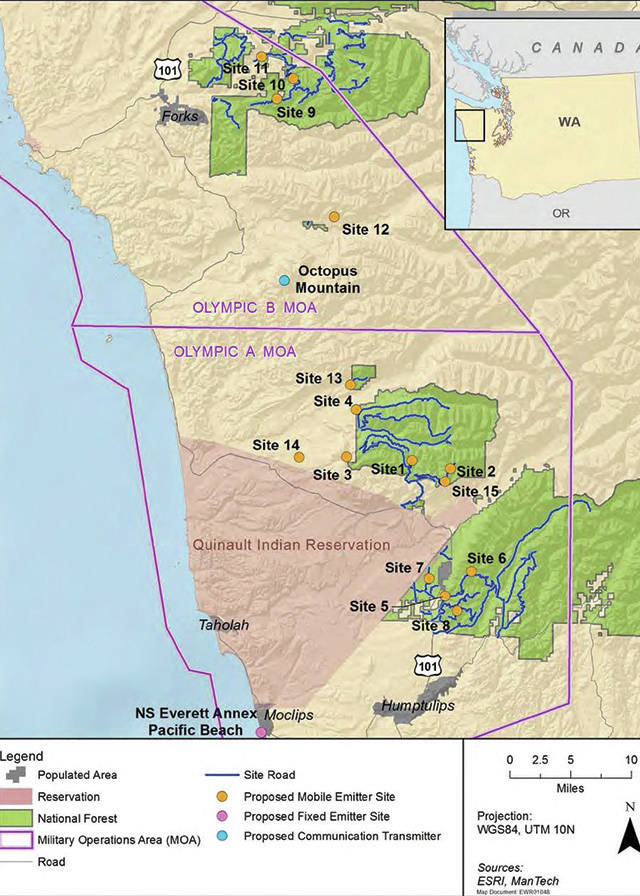By Paul Gottlieb
Peninsula Daily News
The U.S. Forest Service signed a special-use permit Monday allowing the Navy to begin the much-debated electronic-warfare training with mobile-emitter trucks in Olympic National Forest, the agency announced.
The permit was to be sent by the end of Tuesday to Navy officials for their approval, Forest Service spokesman Stephen Baker said.
Navy spokesman Mike Welding said Monday one transmitter truck has been built. He did not know the status of the other two trucks or when Navy officials would sign off on the permit.
Once the Navy signs off on the permit, training exercises linking Naval Air Station Whidbey Island radar-jamming EA-6B Prowler jets with camper-sized vehicles emitting electromagnetic signals can begin, Baker said.
“My understanding is, they are eager to move forward on this,” he said.
Most of the trucks will be located north and south of the Quinault reservation and north of Moclips on the coast, within the western ring of Olympic National Forest.
The permit “outlines the requirements for these activities to take place,” Baker said.
Those requirement included the 11 locations on Forest Service roads where the emitter trucks can park for eight-16 hours a day and interact with training aircraft who will engage in targeting exercises.
Training will not occur on weekends and federal holidays.
Electronic warfare training has been going on above the North Olympic Peninsula since the 1960s, Welding said.
A 1988 master agreement between the Department of Defense and Department of Agriculture, which oversees the Forest Service, established procedures for military activities on Forest Service land.
”For us, it is important to train over there for the fleet and our personnel readiness,” Welding said.
“What this does is, it allows for more realistic war training and that better prepares the servicemen and women who fly these aircraft when they get in harm’s way.
“It’s really about improving the fidelity of the training.”
Pilots currently conduct only in-cockpit training exercises over the area, known as the Northwest Training Range Complex.
The project would “sustain and enhance” the current level of training, according to the Navy’s 2014 final environmental assessment.
A Forest Service draft decision notice was issued in November that establishment of the Pacific Northwest Electronic Warfare Range would result in no significant environmental impact, a decision based on the assessment.
The Forest Service received about 3,500 comments from the public on the project, the vast majority of them negative, Baker said.
Many objected to jet-noise impacts and expressed concerns over electromagnetic signals that will be emitted by the transmitters upward toward aircraft.
The Navy has said flights over Olympic National Park and Olympic National Forest would increase by up to 10 percent — up to one additional flight per day — but that noise levels would not harm wildlife.
“We’ve been working on this for a couple of years,” Baker said. “There’s a lot of local interest.
“That’s one of the reasons why we’ve been wanting to make sure to hear from as many people as we can.”
Baker said the Forest Service worked closely with U.S. Fish and Wildlife Service in determining that the project would not harm wildlife.
Baker said the requirements in the permit include procedures for when hikers and other National Forest visitors go within a 100-foot safety zone around the trucks.
The warfare training crews would stop training activities until the area was cleared or move the transmitters to another location, Baker said.
“A lot of those [requirements] were based on input we received from the planning process,” he said.
Read more about the project at www.tinyurl.com/PDN-Electrowarfare.



